Garage Lifts
#1
Instructor


Thread Starter
I see a good many posts about lifts on this forum. A few I know well and a few I have never seen before (ie. kwiklift). I sell automotive tool and equipment for a living and lifts are one of my staples. I'd like to give back to the forum and highlight the differences in lift types and some qualifying questions for selecting the right lift for you. I'll focus mostly on the hobbyist grade or lower cost professional grade equipment as I think that's what we're mostly into. I'll also give a general rating system for the types of lifts based on a 1-10 rating with 1 being least and 10 being most for cost, capability, safety, and space usage.
When considering a lift, remember there's generally going to be something for every budget that will get you the features you're looking to have. That being said the last thing to consider in your selection is your budget.
The first thing to evaluate is the expected usage and type of work you want to do on your lift.
- Expected max vehicle weight and size
- Is the type of work you do going to require the suspension loaded or unloaded
- How frequently the lift will be used
- Will you be pulling transmissions and rears
- Do you have any interest in doing your own alignments
- Will you be working on vehicles other than your own
Next lets look at some qualitative aspects:
- Physical restrictions (height, width, length)
- Mobile or static
- Mechanical, electrical, pneumatic
- Power service (110 or 220v)
- Concrete: how thick, level, quality
- Any grade going into shop
Last thing to consider is how important is safety to you. How much risk do you want to absorb vs cost.
Those are the main points to have answers for before moving into the lift selection process.
________________________________________ ____________________
Types of lifts:
Pop Up:
These include things like the Kwiklift:
Cost: 1
Capability: 3
Safety: 1
Space: 2
These are the very entree level of all lift types.
They consist of drive on pop up ramps. You can get cross bridges to incorporate make shift rolling jacks to lift the vehicle off the ramps.
Aside from value the best feature of these is mobility. You can move these and store them out of the way extremely easily.
They are the least safe of all options. Dangers come in multiple forms: 1. Total or partial lift collapse; front/rear, side/side. This lift type relies 100% on friction to maintain integrity. If a vehicle bumps into the lift while it is in the air collapse is likely. 2. Using a makeshift rolling jack setup is inconsistent and can be very unstable. 3. These lifts are not ANSI certified (which can mean they're not able to be used in some states and have not undergone a recognised 3rd party quality and safety inspection. **It is worth it to note that even scissor, 2, or 4 posts lifts are not all ANSI certified, but many are.**) 4. Material quality is not disclosed in detail.
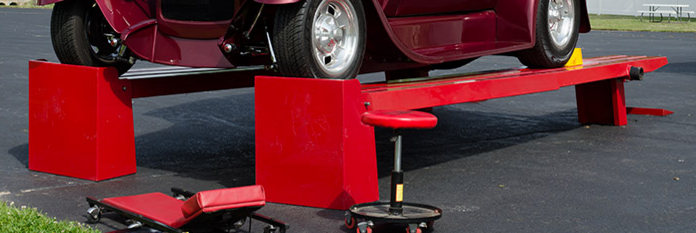
Scissor Lifts:
Cost: 2-5
Capability: 3-5
Safety : 1-5
Space: 2
These lifts take up a small physical footprint and lift from the frame or the wheels. Some have an open center and some have connecting bars. They can be powered by electric or shop air. Scissor lifts come in 3 main configurations, low lift, mid lift, and extra tall lift. They can also have an integral jack (for drive on models) that will lift the vehicle off the ramps from the frame.
They can come in permanent, semi permanent, and mobile configurations.
They can be a relatively safe option so long as you don't try to use it for something it was not designed for, or put something heavy too high in the air or put any axial loads on it. Weight distribution on center-line is also important to consider.
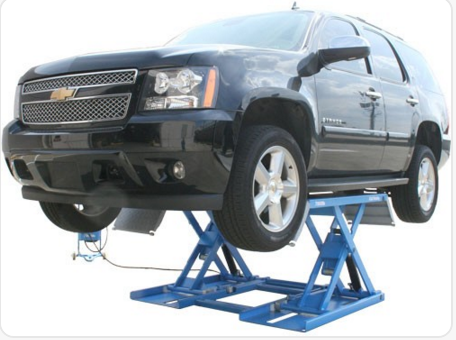
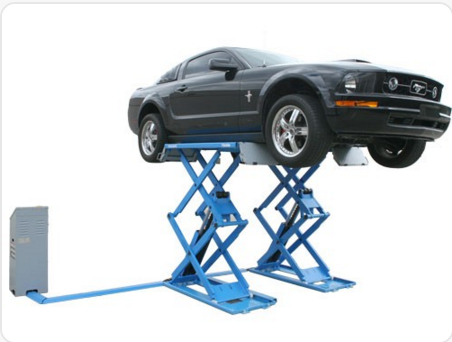
2 Post Lift:
Cost: 4-10
Capability: 4-7
Safety: 1-8
Space: 6-8
These lifts are the most commonly seen lift due to a large variety of uses, configurations, and ease of use.
Like it sounds there are 2 posts that hold the hydraulic pistons that do the lifting. These posts are connected together one of 2 ways, over the top or on the floor. They have 4 swing arms that contact the frame with lift pads. Swing arms come in one of 3 configurations: Symmetrical, Asymetrical, and Versymmetric.
These are generally a very safe type of lift. Each tower has a lock on it giving you a 50% chance of collapse in the event of piston and lock failure. There are 2 dangerous aspects of working with 2 post lifts; 1. Getting the weight in the right place in relation to the lift towers is rather important. Too far forward, back, or side to side can cause the vehicle to fall off the lift while working. 2. If you are pulling an engine, trans, or rear you have to also account for the weight distribution for after the weight is removed. So as you work the danger can increase.
-note* roof height is a critical measurement with overhead cross beams
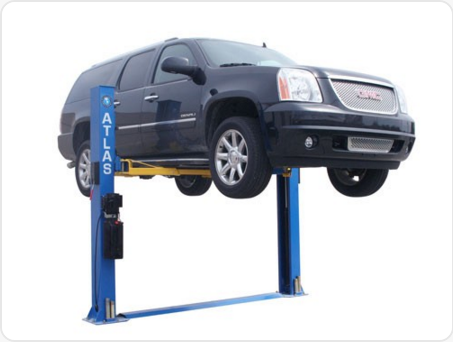
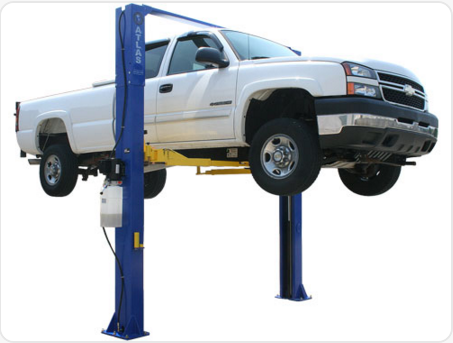
4 Post Lifts:
Cost: 4-10
Capability: 8-10
Safety: 4-10
Space - 8-10
4 Post lifts are the most capable of all lift types and second most common. They have drive up ramps, like pop up lifts, and use 4 towers on each corner with lift pistons. 4 post lifts in most cases have the ability to add powered rolling jacks that slide up and down the center that lift the vehicle off the ramp base by the frame. They can be ordered with rollers and turntables on the ramps for alignment purposes or for whatever else you can put them to use for.
These are also the safest of all lift types. Most manufacturers have a lock on each one of the 4 towers in case of piston failure. This gives you a 25% chance of collapse due to piston and lock failure on a tower. The largest danger comes from driving on and off the ramps. If you aren't lined up well you can damage your car by driving off the end of the ramps (hard to do) or driving off the side of the ramps (just takes a little care). As you work the vehicle is as safe in the air as it was sitting on the ground.
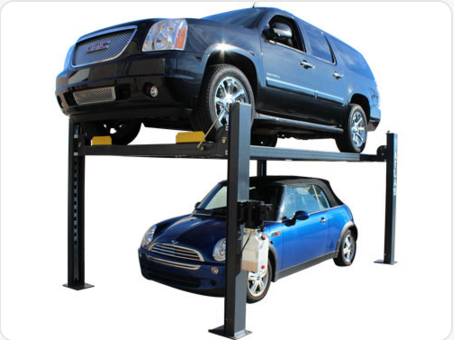
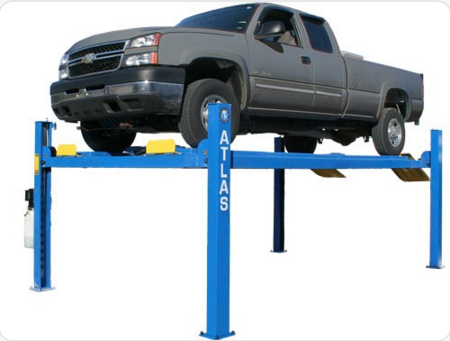
This is lift info 101.
Please let me know if you'd like me to expand on anything further.
When considering a lift, remember there's generally going to be something for every budget that will get you the features you're looking to have. That being said the last thing to consider in your selection is your budget.
The first thing to evaluate is the expected usage and type of work you want to do on your lift.
- Expected max vehicle weight and size
- Is the type of work you do going to require the suspension loaded or unloaded
- How frequently the lift will be used
- Will you be pulling transmissions and rears
- Do you have any interest in doing your own alignments
- Will you be working on vehicles other than your own
Next lets look at some qualitative aspects:
- Physical restrictions (height, width, length)
- Mobile or static
- Mechanical, electrical, pneumatic
- Power service (110 or 220v)
- Concrete: how thick, level, quality
- Any grade going into shop
Last thing to consider is how important is safety to you. How much risk do you want to absorb vs cost.
Those are the main points to have answers for before moving into the lift selection process.
________________________________________ ____________________
Types of lifts:
Pop Up:
These include things like the Kwiklift:
Cost: 1
Capability: 3
Safety: 1
Space: 2
These are the very entree level of all lift types.
They consist of drive on pop up ramps. You can get cross bridges to incorporate make shift rolling jacks to lift the vehicle off the ramps.
Aside from value the best feature of these is mobility. You can move these and store them out of the way extremely easily.
They are the least safe of all options. Dangers come in multiple forms: 1. Total or partial lift collapse; front/rear, side/side. This lift type relies 100% on friction to maintain integrity. If a vehicle bumps into the lift while it is in the air collapse is likely. 2. Using a makeshift rolling jack setup is inconsistent and can be very unstable. 3. These lifts are not ANSI certified (which can mean they're not able to be used in some states and have not undergone a recognised 3rd party quality and safety inspection. **It is worth it to note that even scissor, 2, or 4 posts lifts are not all ANSI certified, but many are.**) 4. Material quality is not disclosed in detail.

Scissor Lifts:
Cost: 2-5
Capability: 3-5
Safety : 1-5
Space: 2
These lifts take up a small physical footprint and lift from the frame or the wheels. Some have an open center and some have connecting bars. They can be powered by electric or shop air. Scissor lifts come in 3 main configurations, low lift, mid lift, and extra tall lift. They can also have an integral jack (for drive on models) that will lift the vehicle off the ramps from the frame.
They can come in permanent, semi permanent, and mobile configurations.
They can be a relatively safe option so long as you don't try to use it for something it was not designed for, or put something heavy too high in the air or put any axial loads on it. Weight distribution on center-line is also important to consider.


2 Post Lift:
Cost: 4-10
Capability: 4-7
Safety: 1-8
Space: 6-8
These lifts are the most commonly seen lift due to a large variety of uses, configurations, and ease of use.
Like it sounds there are 2 posts that hold the hydraulic pistons that do the lifting. These posts are connected together one of 2 ways, over the top or on the floor. They have 4 swing arms that contact the frame with lift pads. Swing arms come in one of 3 configurations: Symmetrical, Asymetrical, and Versymmetric.
These are generally a very safe type of lift. Each tower has a lock on it giving you a 50% chance of collapse in the event of piston and lock failure. There are 2 dangerous aspects of working with 2 post lifts; 1. Getting the weight in the right place in relation to the lift towers is rather important. Too far forward, back, or side to side can cause the vehicle to fall off the lift while working. 2. If you are pulling an engine, trans, or rear you have to also account for the weight distribution for after the weight is removed. So as you work the danger can increase.
-note* roof height is a critical measurement with overhead cross beams


4 Post Lifts:
Cost: 4-10
Capability: 8-10
Safety: 4-10
Space - 8-10
4 Post lifts are the most capable of all lift types and second most common. They have drive up ramps, like pop up lifts, and use 4 towers on each corner with lift pistons. 4 post lifts in most cases have the ability to add powered rolling jacks that slide up and down the center that lift the vehicle off the ramp base by the frame. They can be ordered with rollers and turntables on the ramps for alignment purposes or for whatever else you can put them to use for.
These are also the safest of all lift types. Most manufacturers have a lock on each one of the 4 towers in case of piston failure. This gives you a 25% chance of collapse due to piston and lock failure on a tower. The largest danger comes from driving on and off the ramps. If you aren't lined up well you can damage your car by driving off the end of the ramps (hard to do) or driving off the side of the ramps (just takes a little care). As you work the vehicle is as safe in the air as it was sitting on the ground.


This is lift info 101.
Please let me know if you'd like me to expand on anything further.
Last edited by AW IR C3; 12-28-2015 at 11:04 PM.
The following 4 users liked this post by AW IR C3:
#5
Instructor


Thread Starter
That being said I find Challenger lifts to be of the highest quality in the realm of what we're talking about with Bendpak being my #2 go to.
C3_DK, there's a lot of specialty lifts available in all types of configurations. If you're looking for portability a 2 post would be my last choice for safety. There is no supporting brace between the two towers therefore the entire weight of the vehicle is being held by those under sized bolts (should set in at least 4 inches). So if you're taking them in and out of concrete (even if you have a sleeve in the floor) that will cause fatigue in either the floor concrete, the sleeve, or the bolts. Those are the only thing between you and death. The other thing that truly scares me with that in terms of a hobbyist is that most of us would be down to install it ourselves. A critical piece of lift installation is concrete evaluation, especially with a 2 post. You have to check for depth (4in for 2 post ) and for PSI strength (which you have to use a specialty tool, anyone can get though). Garage pads and driveways are supposed to be 4" thick, however unless you evaluate this you don't know if the contractor skimped on thickness or grade of material or did a rough finish on the ground before pouring. I forsee many people just getting it home and drilling holes for the sleeves without a thought. Lastly, theres no mechanical connection between the two sides to balance the hydraulic pump. If one side gets held up the other side wont know it and you can tip a car that way. For those reasons I wouldn't give that model a second glance. In my opinion. Now Danmar is another very solid lift mfgr on the level with Bendpak and offers other portable lifts. If usable space is concerned I'd look at a 4 post portable.
Last edited by AW IR C3; 12-29-2015 at 09:37 AM.
#6
Drifting


.... You have to check for depth (4in for 2 post ) and for PSI strength (which you have to use a specialty tool, anyone can get though). Garage pads and driveways are supposed to be 4" thick, however unless you evaluate this you don't know if the contractor skimped on thickness or grade of material or did a rough finish on the ground before pouring. I forsee many people just getting it home and drilling holes for the sleeves without a thought. Lastly, theres no mechanical connection between the two sides to balance the hydraulic pump.... .
 well said, I could see a lot of people skipping this.
well said, I could see a lot of people skipping this.
#7
Instructor


I see a good many posts about lifts on this forum. A few I know well and a few I have never seen before (ie. kwiklift). I sell automotive tool and equipment for a living and lifts are one of my staples. I'd like to give back to the forum and highlight the differences in lift types and some qualifying questions for selecting the right lift for you. I'll focus mostly on the hobbyist grade or lower cost professional grade equipment as I think that's what we're mostly into. I'll also give a general rating system for the types of lifts based on a 1-10 rating with 1 being least and 10 being most for cost, capability, safety, and space usage.
When considering a lift, remember there's generally going to be something for every budget that will get you the features you're looking to have. That being said the last thing to consider in your selection is your budget.
The first thing to evaluate is the expected usage and type of work you want to do on your lift.
- Expected max vehicle weight and size
- Is the type of work you do going to require the suspension loaded or unloaded
- How frequently the lift will be used
- Will you be pulling transmissions and rears
- Do you have any interest in doing your own alignments
- Will you be working on vehicles other than your own
Next lets look at some qualitative aspects:
- Physical restrictions (height, width, length)
- Mobile or static
- Mechanical, electrical, pneumatic
- Power service (110 or 220v)
- Concrete: how thick, level, quality
- Any grade going into shop
Last thing to consider is how important is safety to you. How much risk do you want to absorb vs cost.
Those are the main points to have answers for before moving into the lift selection process.
________________________________________ ____________________
Types of lifts:
Pop Up:
These include things like the Kwiklift:
Cost: 1
Capability: 3
Safety: 1
Space: 2
These are the very entree level of all lift types.
They consist of drive on pop up ramps. You can get cross bridges to incorporate make shift rolling jacks to lift the vehicle off the ramps.
Aside from value the best feature of these is mobility. You can move these and store them out of the way extremely easily.
They are the least safe of all options. Dangers come in multiple forms: 1. Total or partial lift collapse; front/rear, side/side. This lift type relies 100% on friction to maintain integrity. If a vehicle bumps into the lift while it is in the air collapse is likely. 2. Using a makeshift rolling jack setup is inconsistent and can be very unstable. 3. These lifts are not ANSI certified (which can mean they're not able to be used in some states and have not undergone a recognised 3rd party quality and safety inspection. **It is worth it to note that even scissor, 2, or 4 posts lifts are not all ANSI certified, but many are.**) 4. Material quality is not disclosed in detail.

Scissor Lifts:
Cost: 2-5
Capability: 3-5
Safety : 1-5
Space: 2
These lifts take up a small physical footprint and lift from the frame or the wheels. Some have an open center and some have connecting bars. They can be powered by electric or shop air. Scissor lifts come in 3 main configurations, low lift, mid lift, and extra tall lift. They can also have an integral jack (for drive on models) that will lift the vehicle off the ramps from the frame.
They can come in permanent, semi permanent, and mobile configurations.
They can be a relatively safe option so long as you don't try to use it for something it was not designed for, or put something heavy too high in the air or put any axial loads on it. Weight distribution on center-line is also important to consider.


2 Post Lift:
Cost: 4-10
Capability: 4-7
Safety: 1-8
Space: 6-8
These lifts are the most commonly seen lift due to a large variety of uses, configurations, and ease of use.
Like it sounds there are 2 posts that hold the hydraulic pistons that do the lifting. These posts are connected together one of 2 ways, over the top or on the floor. They have 4 swing arms that contact the frame with lift pads. Swing arms come in one of 3 configurations: Symmetrical, Asymetrical, and Versymmetric.
These are generally a very safe type of lift. Each tower has a lock on it giving you a 50% chance of collapse in the event of piston and lock failure. There are 2 dangerous aspects of working with 2 post lifts; 1. Getting the weight in the right place in relation to the lift towers is rather important. Too far forward, back, or side to side can cause the vehicle to fall off the lift while working. 2. If you are pulling an engine, trans, or rear you have to also account for the weight distribution for after the weight is removed. So as you work the danger can increase.
-note* roof height is a critical measurement with overhead cross beams


4 Post Lifts:
Cost: 4-10
Capability: 8-10
Safety: 4-10
Space - 8-10
4 Post lifts are the most capable of all lift types and second most common. They have drive up ramps, like pop up lifts, and use 4 towers on each corner with lift pistons. 4 post lifts in most cases have the ability to add powered rolling jacks that slide up and down the center that lift the vehicle off the ramp base by the frame. They can be ordered with rollers and turntables on the ramps for alignment purposes or for whatever else you can put them to use for.
These are also the safest of all lift types. Most manufacturers have a lock on each one of the 4 towers in case of piston failure. This gives you a 25% chance of collapse due to piston and lock failure on a tower. The largest danger comes from driving on and off the ramps. If you aren't lined up well you can damage your car by driving off the end of the ramps (hard to do) or driving off the side of the ramps (just takes a little care). As you work the vehicle is as safe in the air as it was sitting on the ground.


This is lift info 101.
Please let me know if you'd like me to expand on anything further.
When considering a lift, remember there's generally going to be something for every budget that will get you the features you're looking to have. That being said the last thing to consider in your selection is your budget.
The first thing to evaluate is the expected usage and type of work you want to do on your lift.
- Expected max vehicle weight and size
- Is the type of work you do going to require the suspension loaded or unloaded
- How frequently the lift will be used
- Will you be pulling transmissions and rears
- Do you have any interest in doing your own alignments
- Will you be working on vehicles other than your own
Next lets look at some qualitative aspects:
- Physical restrictions (height, width, length)
- Mobile or static
- Mechanical, electrical, pneumatic
- Power service (110 or 220v)
- Concrete: how thick, level, quality
- Any grade going into shop
Last thing to consider is how important is safety to you. How much risk do you want to absorb vs cost.
Those are the main points to have answers for before moving into the lift selection process.
________________________________________ ____________________
Types of lifts:
Pop Up:
These include things like the Kwiklift:
Cost: 1
Capability: 3
Safety: 1
Space: 2
These are the very entree level of all lift types.
They consist of drive on pop up ramps. You can get cross bridges to incorporate make shift rolling jacks to lift the vehicle off the ramps.
Aside from value the best feature of these is mobility. You can move these and store them out of the way extremely easily.
They are the least safe of all options. Dangers come in multiple forms: 1. Total or partial lift collapse; front/rear, side/side. This lift type relies 100% on friction to maintain integrity. If a vehicle bumps into the lift while it is in the air collapse is likely. 2. Using a makeshift rolling jack setup is inconsistent and can be very unstable. 3. These lifts are not ANSI certified (which can mean they're not able to be used in some states and have not undergone a recognised 3rd party quality and safety inspection. **It is worth it to note that even scissor, 2, or 4 posts lifts are not all ANSI certified, but many are.**) 4. Material quality is not disclosed in detail.

Scissor Lifts:
Cost: 2-5
Capability: 3-5
Safety : 1-5
Space: 2
These lifts take up a small physical footprint and lift from the frame or the wheels. Some have an open center and some have connecting bars. They can be powered by electric or shop air. Scissor lifts come in 3 main configurations, low lift, mid lift, and extra tall lift. They can also have an integral jack (for drive on models) that will lift the vehicle off the ramps from the frame.
They can come in permanent, semi permanent, and mobile configurations.
They can be a relatively safe option so long as you don't try to use it for something it was not designed for, or put something heavy too high in the air or put any axial loads on it. Weight distribution on center-line is also important to consider.


2 Post Lift:
Cost: 4-10
Capability: 4-7
Safety: 1-8
Space: 6-8
These lifts are the most commonly seen lift due to a large variety of uses, configurations, and ease of use.
Like it sounds there are 2 posts that hold the hydraulic pistons that do the lifting. These posts are connected together one of 2 ways, over the top or on the floor. They have 4 swing arms that contact the frame with lift pads. Swing arms come in one of 3 configurations: Symmetrical, Asymetrical, and Versymmetric.
These are generally a very safe type of lift. Each tower has a lock on it giving you a 50% chance of collapse in the event of piston and lock failure. There are 2 dangerous aspects of working with 2 post lifts; 1. Getting the weight in the right place in relation to the lift towers is rather important. Too far forward, back, or side to side can cause the vehicle to fall off the lift while working. 2. If you are pulling an engine, trans, or rear you have to also account for the weight distribution for after the weight is removed. So as you work the danger can increase.
-note* roof height is a critical measurement with overhead cross beams


4 Post Lifts:
Cost: 4-10
Capability: 8-10
Safety: 4-10
Space - 8-10
4 Post lifts are the most capable of all lift types and second most common. They have drive up ramps, like pop up lifts, and use 4 towers on each corner with lift pistons. 4 post lifts in most cases have the ability to add powered rolling jacks that slide up and down the center that lift the vehicle off the ramp base by the frame. They can be ordered with rollers and turntables on the ramps for alignment purposes or for whatever else you can put them to use for.
These are also the safest of all lift types. Most manufacturers have a lock on each one of the 4 towers in case of piston failure. This gives you a 25% chance of collapse due to piston and lock failure on a tower. The largest danger comes from driving on and off the ramps. If you aren't lined up well you can damage your car by driving off the end of the ramps (hard to do) or driving off the side of the ramps (just takes a little care). As you work the vehicle is as safe in the air as it was sitting on the ground.


This is lift info 101.
Please let me know if you'd like me to expand on anything further.
#8
Drifting


I bought a 12,000 lb Two-Post lift from Eagle Lifts.. I poured a 24ft x24ft ,6 in deep slab with 36 x36 inch pads ,24 inches deep for the uprights , put 22 inch long anchor bolts in the pads before pouring concrete.. I can assure you mine will never collapse ...
#9
Instructor


Thread Starter
Good product for what it is. I would keep it limited to its intended use for tire changes and light maintenance or if youre a tall bloke to get the engine up to your height. I wouldnt go pulling trans and rears under there. No redundant safety on that unit. You could also use it to jack the car up quick and get some jack stands on the frame too.
Last edited by AW IR C3; 12-29-2015 at 01:11 PM.
#10
Drifting


[QUOTE=AW IR C3;1591209612]JESUS! Yea I think you could lift a Saturn V rocket without worries! Got that sucker steel reinforced too?
double Wire Mesh and 5/8 rebar .. just in case...lol
double Wire Mesh and 5/8 rebar .. just in case...lol

#11
Instructor


Thread Starter
#12
Le Mans Master


Good product for what it is. I would keep it limited to its intended use for tire changes and light maintenance or if youre a tall bloke to get the engine up to your height. I wouldnt go pulling trans and rears under there. No redundant safety on that unit. You could also use it to jack the car up quick and get some jack stands on the frame too.
I did a T5 on jack stands and it was tight. The Quickjack would have been nice for the extra height.
#14
I see a good many posts about lifts on this forum. A few I know well and a few I have never seen before (ie. kwiklift). I sell automotive tool and equipment for a living and lifts are one of my staples. I'd like to give back to the forum and highlight the differences in lift types and some qualifying questions for selecting the right lift for you. I'll focus mostly on the hobbyist grade or lower cost professional grade equipment as I think that's what we're mostly into. I'll also give a general rating system for the types of lifts based on a 1-10 rating with 1 being least and 10 being most for cost, capability, safety, and space usage.
When considering a lift, remember there's generally going to be something for every budget that will get you the features you're looking to have. That being said the last thing to consider in your selection is your budget.
The first thing to evaluate is the expected usage and type of work you want to do on your lift.
- Expected max vehicle weight and size
- Is the type of work you do going to require the suspension loaded or unloaded
- How frequently the lift will be used
- Will you be pulling transmissions and rears
- Do you have any interest in doing your own alignments
- Will you be working on vehicles other than your own
Next lets look at some qualitative aspects:
- Physical restrictions (height, width, length)
- Mobile or static
- Mechanical, electrical, pneumatic
- Power service (110 or 220v)
- Concrete: how thick, level, quality
- Any grade going into shop
Last thing to consider is how important is safety to you. How much risk do you want to absorb vs cost.
Those are the main points to have answers for before moving into the lift selection process.
________________________________________ ____________________
Types of lifts:
Pop Up:
These include things like the Kwiklift:
Cost: 1
Capability: 3
Safety: 1
Space: 2
These are the very entree level of all lift types.
They consist of drive on pop up ramps. You can get cross bridges to incorporate make shift rolling jacks to lift the vehicle off the ramps.
Aside from value the best feature of these is mobility. You can move these and store them out of the way extremely easily.
They are the least safe of all options. Dangers come in multiple forms: 1. Total or partial lift collapse; front/rear, side/side. This lift type relies 100% on friction to maintain integrity. If a vehicle bumps into the lift while it is in the air collapse is likely. 2. Using a makeshift rolling jack setup is inconsistent and can be very unstable. 3. These lifts are not ANSI certified (which can mean they're not able to be used in some states and have not undergone a recognised 3rd party quality and safety inspection. **It is worth it to note that even scissor, 2, or 4 posts lifts are not all ANSI certified, but many are.**) 4. Material quality is not disclosed in detail.

Scissor Lifts:
Cost: 2-5
Capability: 3-5
Safety : 1-5
Space: 2
These lifts take up a small physical footprint and lift from the frame or the wheels. Some have an open center and some have connecting bars. They can be powered by electric or shop air. Scissor lifts come in 3 main configurations, low lift, mid lift, and extra tall lift. They can also have an integral jack (for drive on models) that will lift the vehicle off the ramps from the frame.
They can come in permanent, semi permanent, and mobile configurations.
They can be a relatively safe option so long as you don't try to use it for something it was not designed for, or put something heavy too high in the air or put any axial loads on it. Weight distribution on center-line is also important to consider.


2 Post Lift:
Cost: 4-10
Capability: 4-7
Safety: 1-8
Space: 6-8
These lifts are the most commonly seen lift due to a large variety of uses, configurations, and ease of use.
Like it sounds there are 2 posts that hold the hydraulic pistons that do the lifting. These posts are connected together one of 2 ways, over the top or on the floor. They have 4 swing arms that contact the frame with lift pads. Swing arms come in one of 3 configurations: Symmetrical, Asymetrical, and Versymmetric.
These are generally a very safe type of lift. Each tower has a lock on it giving you a 50% chance of collapse in the event of piston and lock failure. There are 2 dangerous aspects of working with 2 post lifts; 1. Getting the weight in the right place in relation to the lift towers is rather important. Too far forward, back, or side to side can cause the vehicle to fall off the lift while working. 2. If you are pulling an engine, trans, or rear you have to also account for the weight distribution for after the weight is removed. So as you work the danger can increase.
-note* roof height is a critical measurement with overhead cross beams


4 Post Lifts:
Cost: 4-10
Capability: 8-10
Safety: 4-10
Space - 8-10
4 Post lifts are the most capable of all lift types and second most common. They have drive up ramps, like pop up lifts, and use 4 towers on each corner with lift pistons. 4 post lifts in most cases have the ability to add powered rolling jacks that slide up and down the center that lift the vehicle off the ramp base by the frame. They can be ordered with rollers and turntables on the ramps for alignment purposes or for whatever else you can put them to use for.
These are also the safest of all lift types. Most manufacturers have a lock on each one of the 4 towers in case of piston failure. This gives you a 25% chance of collapse due to piston and lock failure on a tower. The largest danger comes from driving on and off the ramps. If you aren't lined up well you can damage your car by driving off the end of the ramps (hard to do) or driving off the side of the ramps (just takes a little care). As you work the vehicle is as safe in the air as it was sitting on the ground.


This is lift info 101.
Please let me know if you'd like me to expand on anything further.
When considering a lift, remember there's generally going to be something for every budget that will get you the features you're looking to have. That being said the last thing to consider in your selection is your budget.
The first thing to evaluate is the expected usage and type of work you want to do on your lift.
- Expected max vehicle weight and size
- Is the type of work you do going to require the suspension loaded or unloaded
- How frequently the lift will be used
- Will you be pulling transmissions and rears
- Do you have any interest in doing your own alignments
- Will you be working on vehicles other than your own
Next lets look at some qualitative aspects:
- Physical restrictions (height, width, length)
- Mobile or static
- Mechanical, electrical, pneumatic
- Power service (110 or 220v)
- Concrete: how thick, level, quality
- Any grade going into shop
Last thing to consider is how important is safety to you. How much risk do you want to absorb vs cost.
Those are the main points to have answers for before moving into the lift selection process.
________________________________________ ____________________
Types of lifts:
Pop Up:
These include things like the Kwiklift:
Cost: 1
Capability: 3
Safety: 1
Space: 2
These are the very entree level of all lift types.
They consist of drive on pop up ramps. You can get cross bridges to incorporate make shift rolling jacks to lift the vehicle off the ramps.
Aside from value the best feature of these is mobility. You can move these and store them out of the way extremely easily.
They are the least safe of all options. Dangers come in multiple forms: 1. Total or partial lift collapse; front/rear, side/side. This lift type relies 100% on friction to maintain integrity. If a vehicle bumps into the lift while it is in the air collapse is likely. 2. Using a makeshift rolling jack setup is inconsistent and can be very unstable. 3. These lifts are not ANSI certified (which can mean they're not able to be used in some states and have not undergone a recognised 3rd party quality and safety inspection. **It is worth it to note that even scissor, 2, or 4 posts lifts are not all ANSI certified, but many are.**) 4. Material quality is not disclosed in detail.

Scissor Lifts:
Cost: 2-5
Capability: 3-5
Safety : 1-5
Space: 2
These lifts take up a small physical footprint and lift from the frame or the wheels. Some have an open center and some have connecting bars. They can be powered by electric or shop air. Scissor lifts come in 3 main configurations, low lift, mid lift, and extra tall lift. They can also have an integral jack (for drive on models) that will lift the vehicle off the ramps from the frame.
They can come in permanent, semi permanent, and mobile configurations.
They can be a relatively safe option so long as you don't try to use it for something it was not designed for, or put something heavy too high in the air or put any axial loads on it. Weight distribution on center-line is also important to consider.


2 Post Lift:
Cost: 4-10
Capability: 4-7
Safety: 1-8
Space: 6-8
These lifts are the most commonly seen lift due to a large variety of uses, configurations, and ease of use.
Like it sounds there are 2 posts that hold the hydraulic pistons that do the lifting. These posts are connected together one of 2 ways, over the top or on the floor. They have 4 swing arms that contact the frame with lift pads. Swing arms come in one of 3 configurations: Symmetrical, Asymetrical, and Versymmetric.
These are generally a very safe type of lift. Each tower has a lock on it giving you a 50% chance of collapse in the event of piston and lock failure. There are 2 dangerous aspects of working with 2 post lifts; 1. Getting the weight in the right place in relation to the lift towers is rather important. Too far forward, back, or side to side can cause the vehicle to fall off the lift while working. 2. If you are pulling an engine, trans, or rear you have to also account for the weight distribution for after the weight is removed. So as you work the danger can increase.
-note* roof height is a critical measurement with overhead cross beams


4 Post Lifts:
Cost: 4-10
Capability: 8-10
Safety: 4-10
Space - 8-10
4 Post lifts are the most capable of all lift types and second most common. They have drive up ramps, like pop up lifts, and use 4 towers on each corner with lift pistons. 4 post lifts in most cases have the ability to add powered rolling jacks that slide up and down the center that lift the vehicle off the ramp base by the frame. They can be ordered with rollers and turntables on the ramps for alignment purposes or for whatever else you can put them to use for.
These are also the safest of all lift types. Most manufacturers have a lock on each one of the 4 towers in case of piston failure. This gives you a 25% chance of collapse due to piston and lock failure on a tower. The largest danger comes from driving on and off the ramps. If you aren't lined up well you can damage your car by driving off the end of the ramps (hard to do) or driving off the side of the ramps (just takes a little care). As you work the vehicle is as safe in the air as it was sitting on the ground.


This is lift info 101.
Please let me know if you'd like me to expand on anything further.
ZIO
#15
Instructor


Thread Starter
#16
Drifting


Thank you for creating this thread AW IR C3. I have been presented with the opportunity to buy a used 7000 pound capacity Back Yard Buddy lift. This particular lift will allow me to satisfy my primary objective of providing a place to park another hobby car in my garage at my house. My question is this: is the dis-assembly, transport and reassembly (at my house) something I should consider doing myself? If so, is the weight of the individual pieces (after dis-assembly) manageable for a couple of 50 something guys with a pickup truck to load/unload without much difficulty? If the answer to either of these questions is no, are there companies that will do what I've described for a fee? Disclaimer: I've never assembled and setup a lift before and a value to opinion of someone such as yourself that has years of experience with garage lifts.
Thanks,
Rick
Thanks,
Rick
Last edited by AkrHack; 12-29-2015 at 11:12 PM.
#17
Instructor


Thread Starter
Thank you for creating this thread AW IR C3. I have been presented with the opportunity to buy a used 7000 pound capacity Back Yard Buddy lift. This particular lift will allow me to satisfy my primary objective of providing a place to park another hobby car in my garage at my house. My question is this: is the dis-assembly, transport and reassembly (at my house) something I should consider doing myself? If so, is the weight of the individual pieces (after dis-assembly) manageable for a couple of 50 something guys with a pickup truck to load/unload without much difficulty? If the answer to either of these questions is no, are there companies that will do what I've described for a fee? Disclaimer: I've never assembled and setup a lift before and a value to opinion of someone such as yourself that has years of experience with garage lifts.
Thanks,
Rick
Thanks,
Rick
As far as who can do it, do a google search for "lift installers near me". Baring success there you can call up the tech line for any of the major lift manufacturers and ask if they can recommend an installer in your area.
If you find you cant transport the lift you can ask any local tow company if they would be willing to transport it on the back of a flatbed. If you have to go that route and the cost of transportation sounds prohibitive and makes you consider a new lift, remember this: when you get a new lift delivered there is typically a lift gate fee unless you have a forklift or someway to unload it. Lift gate fees range from $150-500 for the lifts we're talking about.
Good luck with your purchase and I hope you have many years of enjoyment!

#18
Instructor


Thread Starter
Thank you for creating this thread AW IR C3. I have been presented with the opportunity to buy a used 7000 pound capacity Back Yard Buddy lift. This particular lift will allow me to satisfy my primary objective of providing a place to park another hobby car in my garage at my house. My question is this: is the dis-assembly, transport and reassembly (at my house) something I should consider doing myself? If so, is the weight of the individual pieces (after dis-assembly) manageable for a couple of 50 something guys with a pickup truck to load/unload without much difficulty? If the answer to either of these questions is no, are there companies that will do what I've described for a fee? Disclaimer: I've never assembled and setup a lift before and a value to opinion of someone such as yourself that has years of experience with garage lifts.
Thanks,
Rick
Thanks,
Rick
As far as who can do it, do a google search for "lift installers near me". Baring success there you can call up the tech line for any of the major lift manufacturers and ask if they can recommend an installer in your area.
If you find you cant transport the lift you can ask any local tow company if they would be willing to transport it on the back of a flatbed. If you have to go that route and the cost of transportation sounds prohibitive and makes you consider a new lift, remember this: when you get a new lift delivered there is typically a lift gate fee unless you have a forklift or someway to unload it. Lift gate fees range from $150-500 for the lifts we're talking about.
Good luck with your purchase and I hope you have many years of enjoyment!

Last edited by AW IR C3; 12-30-2015 at 12:00 AM.
#20
Race Director


I went and picked up my first two post lift with a rented uhaul trailer. They loaded it on with a forklift and I pulled it apart when I got home. It was about an hour away. My 4 post that I have now I had access to a car trailer. I went down and picked it up the same way. When I got home disassembled it on the trailer. I was able to load the real heavy pieces onto furniture Dolly's and wheel them up the driveway in the garage. Once all the pieces were in the garage I was able to assemble it. If you have access to a trailer that is capable of hauling 2000 lbs you should be able to pick it up.
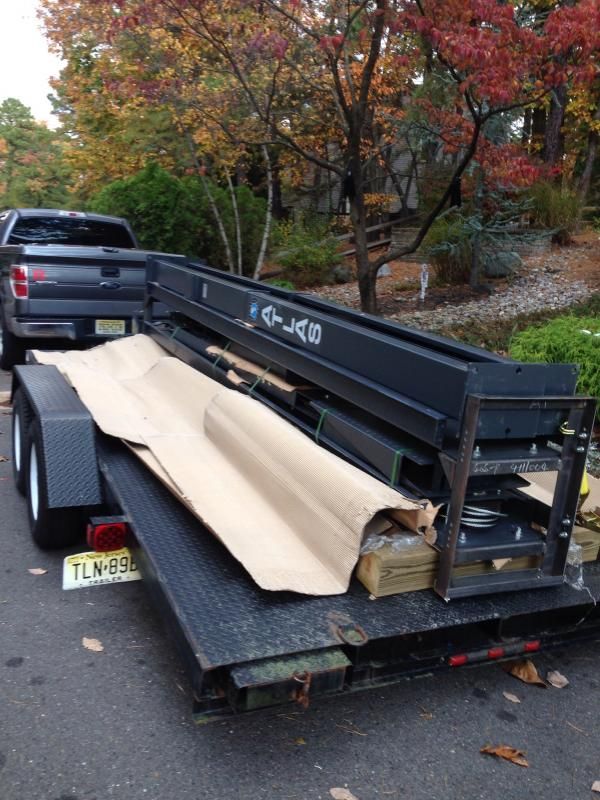

Last edited by Gordonm; 12-30-2015 at 09:09 AM.








